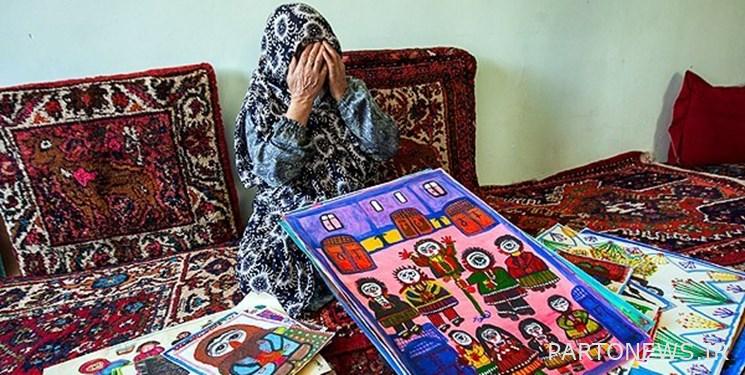The story of a village lady who became a painter at the age of 70/”Nene Hassan” passed away

Fars News Agency – visual group: Yesterday, Monday, the 31st of August 1401, Ms. Manoor Ramezani, known as “Nene Hassan”, a self-taught painter, died. For this reason, we have tried to take a look at the works and life of this particular artist. An artist who entered the field of painting and art late and in old age, but in the same short period of time, he lived an impressive and memorable artistic life.
Manour Ramezani, known as Nene Hassan, born in 1316 in Sohrvard and a resident of Khodabande city, Kedar city, Zanjan province, is a self-taught Iranian painter. He started painting in his old age at the age of 70. The subject of his paintings are the stories, beliefs and lifestyle of people in the villages of Azerbaijan and an important part of the oral literature around him that was in danger of being forgotten. Hassan Rajabi, the little son of this painter’s mother, who is also an artist, was his encouragement and supporter for painting.
In an exhibition of his mother’s works that was held in Shirin Gallery in 2013, he said about his mother’s interest in the art of painting: “My mother started painting with a pen in 2007 and put her worldview on paper. When I saw his interest and talent, I introduced him to other materials. Now he works with other materials such as acrylic. In 1978, I was working with black ink and my mother sat by my hand and worked on my works. His works were very special from my point of view, so I encouraged him to work more and paint.
He added: “Stories and memories of different periods of life, national and local myths and dreams that my mother sees have the greatest impact on her paintings. My mother has been weaving carpets since she was seven years old. The patterns they weave in their carpets have been passed down to him and now he brings them to the canvas. He used to make dyes for his own carpet weaving, and this made my mother a master in the field of dyes and know their world well. My mother’s work was completely experimental. The patterns he used in his carpets can be seen in his paintings today. “After a few years, he has a special style for himself and works quite creatively.”

He mentioned the ups and downs of his mother’s life and its relationship with the works and concepts of her paintings and said: “My mother is full of experiences and learnings that she inherited from her ancestors, which includes stories and ancient rituals that These mental knowledge of my mother can be seen in the form of paintings, knowledge that shows the originality of my mother’s art.
Nene Hassan’s first exhibition was held at the artists’ house and was well received. Later, an exhibition in Los Angeles hosted his paintings.

Nene Hassan was also present for her exhibition at Tehran Artists’ House. The opening was crowded and everyone was happy to see Nene Hassan and her works. He was also busy painting the exhibition space.

Nene Hassan was a resident of Khodabandeh city. By drawing the traditional way of life in the countryside of Azerbaijan, which has been forgotten with the passage of time, he depicts an important part of the oral literature around him.

Life, nature and man are important and common characteristics of most of the works of this artist, and the way of representing the images is reminiscent of the ancient roles and works of ancient civilizations, as if he learned this way of representation directly from his predecessors and inherited what they considered to be their heritage.

Nene Hassan says this about herself and her art:
“I am Manour Ramadani. Born in Suhrvard village of Khodabande village in Zanjan. I used to weave carpets with my family and paint the patterns of the carpets. I used to draw lions, tigers and horses, and I used to paint giraffes and ladies. After that, I would weave those carpets from the patterns I had drawn and hand them over to my father and family to sell. I liked to read old books. I remember that someone was brought to me to teach me. “My mother didn’t like me to draw and fall behind in my studies.”

“I paint whatever comes to my mind. I like to paint swords and wars or family customs from old books. In my childhood, books and stories were read to me and they remained in my mind. From Rostam and Sohrab to the wedding ceremony and mourning, all the stories are imprinted in my mind. I have been weaving carpets since the age of five until the past few years. Even now that I am 75 years old, I am happy and sometimes I still weave carpets and make bread. “We weave carpets and my brother-in-law used to sell them to make ends meet.”

(Grandma Hassan says, pointing to a painting) “Once I had a dream that I wanted to go to Mecca for pilgrimage. My son and I were on the way to Mecca, and my son took a white road and reached the end of the moon road, but I took the road that did not reach Mecca and returned. I woke up at that moment.”

“God has given me the mind to draw at this age. I am leaving and these will remain. I write stories that stick in minds. Sometimes I get emotional by painting, or if God forbid I lose a loved one, I prefer to paint in those situations. “The only way to escape from pressure and sadness is to draw a picture.”















end of message/
You can edit this article
Suggest this article for the first page

